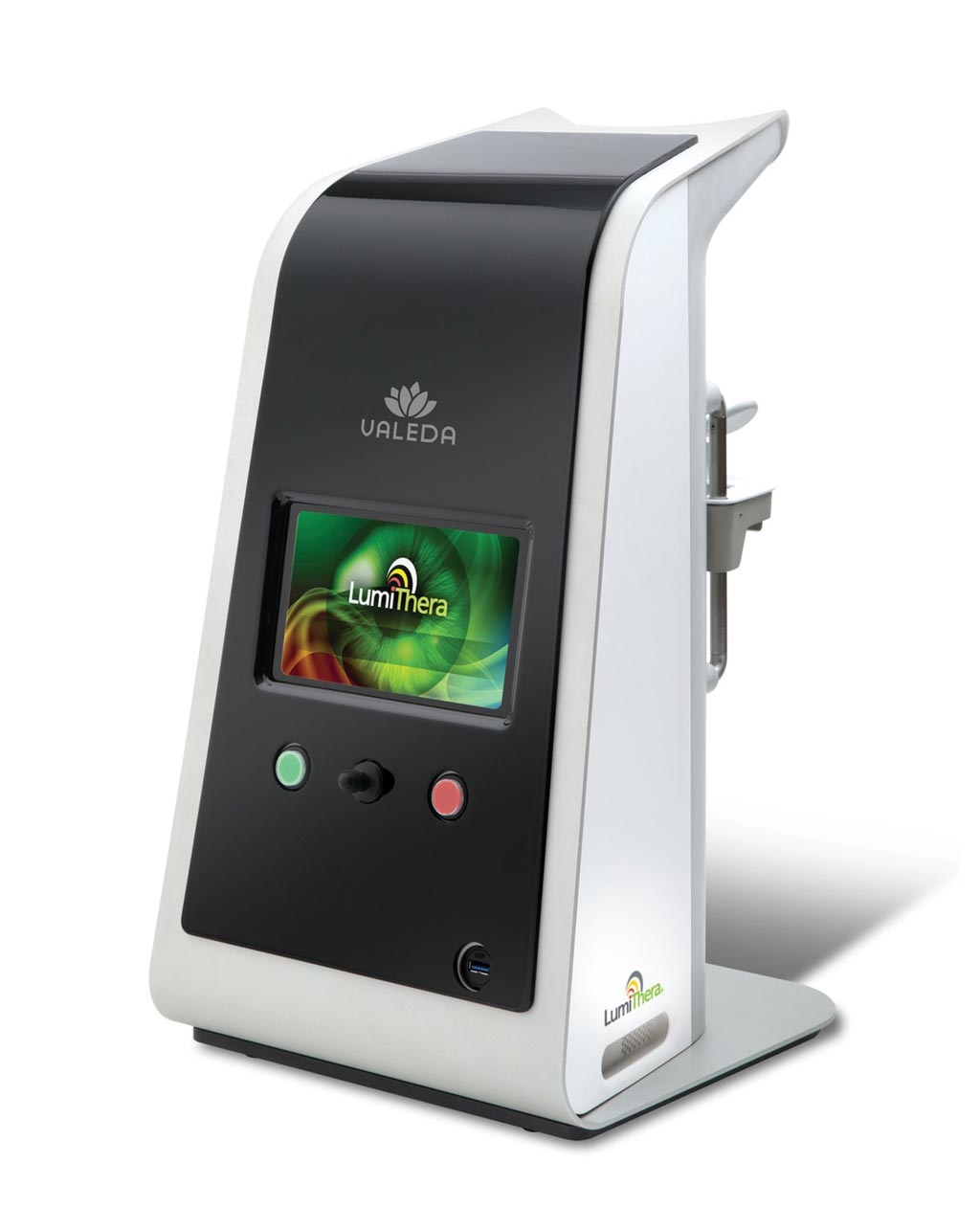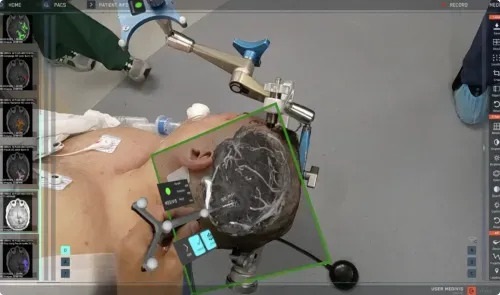Photobiomodulation Device Treats Macular Degeneration
|
By HospiMedica International staff writers Posted on 27 Jun 2019 |

Image: The Valeda Light Delivery System (Photo courtesy of LumiThera).
A novel photobiomodulation (PBM) system uses low-level light to stimulate cellular function in order to treat age-related macular degeneration (AMD).
The LumiThera (Poulsbo, WA, USA) Valeda Light Delivery System is designed to deliver a series of photobiomodulation (PBM) treatments at selected wavelengths to the retinal cells--one of the most energy-dependent cells in the body--in order to activate mitochondrial respiratory chain components via photon absorption by photoacceptors in the targeted tissue. The key photoacceptor in the retina--in the far red to near-infrared (NIR) spectral range--is cytochrome C oxidase (CCO), a critical protein involved in regulation of mitochondrial activity.
Once absorbed, cellular changes occur by activation of transcription factors, leading to modulation in protein synthesis, stabilization of metabolic function, and initiation of a signaling cascade that promotes cellular proliferation and cytoprotection, ultimately improved cell survival. Secondary cellular effects include increases in energy production and changes in several signaling modalities, such as in reactive oxygen species (ROS), nitric oxide (NO), and cellular calcium. The improved energy production also addresses the inflammation, ischemia, and metabolic dysfunction that contribute to AMD.
“Dry AMD is one of the largest unmet medical needs in medicine and its prevalence is increasing as we live longer. In ophthalmology, currently, we have no therapies that can be offered to these patients,” said Professor Quan Dong Nguyen, MD, of Stanford University (CA, USA) School of Medicine. “Many of our colleagues at Stanford, in the U.S, and throughout the world, recognize the potential that PBM could provide as an early treatment for dry AMD, and if so, can bring significant benefits to millions of patients globally.”
AMD is a major cause of blindness and visual impairment in the center of the visual field (the macula) due to damage to the retina. Occurring in both dry and wet forms, AMD makes it difficult or impossible to read or recognize faces, although enough peripheral vision remains to allow other activities of daily life. In the dry (nonexudative) form, cellular debris called drusen accumulates between the retina and the choroid, and the retina can become detached. In the more severe wet (exudative) form, blood vessels grow from the choroid behind the retina, and the retina can also become detached.
Related Links:
LumiThera
The LumiThera (Poulsbo, WA, USA) Valeda Light Delivery System is designed to deliver a series of photobiomodulation (PBM) treatments at selected wavelengths to the retinal cells--one of the most energy-dependent cells in the body--in order to activate mitochondrial respiratory chain components via photon absorption by photoacceptors in the targeted tissue. The key photoacceptor in the retina--in the far red to near-infrared (NIR) spectral range--is cytochrome C oxidase (CCO), a critical protein involved in regulation of mitochondrial activity.
Once absorbed, cellular changes occur by activation of transcription factors, leading to modulation in protein synthesis, stabilization of metabolic function, and initiation of a signaling cascade that promotes cellular proliferation and cytoprotection, ultimately improved cell survival. Secondary cellular effects include increases in energy production and changes in several signaling modalities, such as in reactive oxygen species (ROS), nitric oxide (NO), and cellular calcium. The improved energy production also addresses the inflammation, ischemia, and metabolic dysfunction that contribute to AMD.
“Dry AMD is one of the largest unmet medical needs in medicine and its prevalence is increasing as we live longer. In ophthalmology, currently, we have no therapies that can be offered to these patients,” said Professor Quan Dong Nguyen, MD, of Stanford University (CA, USA) School of Medicine. “Many of our colleagues at Stanford, in the U.S, and throughout the world, recognize the potential that PBM could provide as an early treatment for dry AMD, and if so, can bring significant benefits to millions of patients globally.”
AMD is a major cause of blindness and visual impairment in the center of the visual field (the macula) due to damage to the retina. Occurring in both dry and wet forms, AMD makes it difficult or impossible to read or recognize faces, although enough peripheral vision remains to allow other activities of daily life. In the dry (nonexudative) form, cellular debris called drusen accumulates between the retina and the choroid, and the retina can become detached. In the more severe wet (exudative) form, blood vessels grow from the choroid behind the retina, and the retina can also become detached.
Related Links:
LumiThera
Latest Patient Care News
- First-Of-Its-Kind Portable Germicidal Light Technology Disinfects High-Touch Clinical Surfaces in Seconds
- Surgical Capacity Optimization Solution Helps Hospitals Boost OR Utilization

- Game-Changing Innovation in Surgical Instrument Sterilization Significantly Improves OR Throughput
- Next Gen ICU Bed to Help Address Complex Critical Care Needs
- Groundbreaking AI-Powered UV-C Disinfection Technology Redefines Infection Control Landscape
- Clean Hospitals Can Reduce Antibiotic Resistance, Save Lives
- Smart Hospital Beds Improve Accuracy of Medical Diagnosis
- New Fast Endoscope Drying System Improves Productivity and Traceability
- World’s First Automated Endoscope Cleaner Fights Antimicrobial Resistance
- Portable High-Capacity Digital Stretcher Scales Provide Precision Weighing for Patients in ER
- Portable Clinical Scale with Remote Indicator Allows for Flexible Patient Weighing Use
- Innovative and Highly Customizable Medical Carts Offer Unlimited Configuration Possibilities
- Biomolecular Wound Healing Film Adheres to Sensitive Tissue and Releases Active Ingredients
- Wearable Health Tech Could Measure Gases Released From Skin to Monitor Metabolic Diseases
- Wearable Cardioverter Defibrillator System Protects Patients at Risk of Sudden Cardiac Arrest
- World's First AI-Ready Infrasound Stethoscope Listens to Bodily Sounds Not Audible to Human Ear
Channels
Artificial Intelligence
view channel
AI-Powered Algorithm to Revolutionize Detection of Atrial Fibrillation
Atrial fibrillation (AFib), a condition characterized by an irregular and often rapid heart rate, is linked to increased risks of stroke and heart failure. This is because the irregular heartbeat in AFib... Read more
AI Diagnostic Tool Accurately Detects Valvular Disorders Often Missed by Doctors
Doctors generally use stethoscopes to listen for the characteristic lub-dub sounds made by heart valves opening and closing. They also listen for less prominent sounds that indicate problems with these valves.... Read moreCritical Care
view channel.jpeg)
Transcatheter Valve Replacement Outcomes Similar To Surgery, Finds Study
A new study has shown that a minimally invasive procedure for replacing the aortic valve in the heart—known as transcatheter aortic valve replacement (TAVR)—is on par with the more traditional surgical... Read more
Revascularization Improves Life Quality in Chronic Limb-Threatening Ischemia, Finds Study
Researchers have undertaken a detailed study to evaluate the effects of revascularization strategies on the health-related quality of life (HRQoL) of patients with chronic limb-threatening ischemia.... Read moreSurgical Techniques
view channel
AR Surgical Technology Translates Complex 2D Medical Imaging to Enhance Accuracy
Surgeons often have to switch their focus between a patient’s data displayed on a screen or clipboard and the patient themselves during procedures. But that is about to change. Surgeons can now utilize... Read more
Miniaturized Snake-Like Probe Images Cerebral Arteries From Within
Endovascular interventions are being increasingly favored for treating strokes and cerebral artery diseases, but rely heavily on angiographical imaging that often struggles with limited contrast and spatial... Read moreHealth IT
view channel
Machine Learning Model Improves Mortality Risk Prediction for Cardiac Surgery Patients
Machine learning algorithms have been deployed to create predictive models in various medical fields, with some demonstrating improved outcomes compared to their standard-of-care counterparts.... Read more
Strategic Collaboration to Develop and Integrate Generative AI into Healthcare
Top industry experts have underscored the immediate requirement for healthcare systems and hospitals to respond to severe cost and margin pressures. Close to half of U.S. hospitals ended 2022 in the red... Read more
AI-Enabled Operating Rooms Solution Helps Hospitals Maximize Utilization and Unlock Capacity
For healthcare organizations, optimizing operating room (OR) utilization during prime time hours is a complex challenge. Surgeons and clinics face difficulties in finding available slots for booking cases,... Read more
AI Predicts Pancreatic Cancer Three Years before Diagnosis from Patients’ Medical Records
Screening for common cancers like breast, cervix, and prostate cancer relies on relatively simple and highly effective techniques, such as mammograms, Pap smears, and blood tests. These methods have revolutionized... Read morePoint of Care
view channel
Critical Bleeding Management System to Help Hospitals Further Standardize Viscoelastic Testing
Surgical procedures are often accompanied by significant blood loss and the subsequent high likelihood of the need for allogeneic blood transfusions. These transfusions, while critical, are linked to various... Read more
Point of Care HIV Test Enables Early Infection Diagnosis for Infants
Early diagnosis and initiation of treatment are crucial for the survival of infants infected with HIV (human immunodeficiency virus). Without treatment, approximately 50% of infants who acquire HIV during... Read more
Whole Blood Rapid Test Aids Assessment of Concussion at Patient's Bedside
In the United States annually, approximately five million individuals seek emergency department care for traumatic brain injuries (TBIs), yet over half of those suspecting a concussion may never get it checked.... Read more
New Generation Glucose Hospital Meter System Ensures Accurate, Interference-Free and Safe Use
A new generation glucose hospital meter system now comes with several features that make hospital glucose testing easier and more secure while continuing to offer accuracy, freedom from interference, and... Read moreBusiness
view channel
Johnson & Johnson Acquires Cardiovascular Medical Device Company Shockwave Medical
Johnson & Johnson (New Brunswick, N.J., USA) and Shockwave Medical (Santa Clara, CA, USA) have entered into a definitive agreement under which Johnson & Johnson will acquire all of Shockwave’s... Read more

















